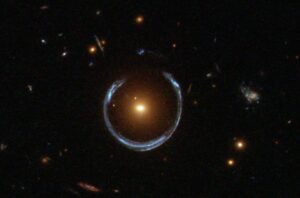The James Webb Space Telescope (JWST) keeps on delivering. Even on subjects so far away that their light takes billions of years to reach it.
That’s the case with the sensational telescope’s latest finds: two galaxies that constitute the second and fourth most distant such objects ever found. They’re not only far away, but incredibly ancient — each one dates to just 330 million years after the Big Bang.
At that rate, the light the JWST caught from them had been traveling for 13 billion years by the time it reached its lens.
“The light from these galaxies is ancient, about three times older than the Earth,” Joel Leja, assistant professor of astronomy and astrophysics at Pennsylvania State University and co-author of a new study on the galaxies, said in a press release. (Earth is about 4.5 billion years old.) “It is only by their light that we can begin to understand the exotic physics that governed the [galaxies] near the cosmic dawn.”
The earliest known galaxy
The JWST also detected the earliest known galaxy, JADES-GS-z13-0, which is about 30 million years younger than these two slightly newer ones.
To find them, researchers focused the telescope on Pandora’s Cluster, or Abell 2744. This enormous array of galaxies contains as much mass as 4 trillion suns, according to NASA. The JWST first focused on it in 2022, its first year of scientific operability. That’s because its location causes special distortions that actually help the telescope examine in better detail.

Astronomers estimate this image of the Pandora Cluster contains 50,000 sources of near-infrared light. Photo: NASA, ESA, CSA, I. Labbe (Swinburne University of Technology) and R. Bezanson (University of Pittsburgh). Image processing: Alyssa Pagan (STScI)
Multiple galaxy clusters in front of Pandora’s Cluster create a natural magnification effect called gravitational lensing. The objects’ combined mass creates gravitational effects that can warp space. This focuses and magnifies light traveling nearby, which enlarges the area behind each cluster, the Penn State team explained.
To find these primordial galaxies, they culled a field of 60,000 light sources down to 700 for follow-up study.
It was still a leap of faith, Leja said.
Rolling the dice
“The fact that we’re pointing at this giant magnifying lens in space gives us an incredibly deep window, but it’s a very small window, so we were rolling the dice. Several of the candidates were inconclusive, and at least one was a case of mistaken identity — it was something much closer that mimics a distant galaxy. But we were lucky, and two turned out to be these ancient galaxies. It’s incredible,” he concluded.
Amazingly, at least one of the galaxies is also tiny — about 2,000 light-years across, compared to the Milky Way at 100,000. But that’s to be expected, because material was likely much more compressed in the era of the Big Bang.
The ancient light also contained clues about the galaxies’ early composition. Metals were scarce, size was increasing, and stars were forming quickly.
“It makes sense that these early galaxies don’t have heavy elements like metals because they were some of the first factories to build those heavy elements. And of course, they would have to be young and star-forming to be the first galaxies,” Leja said. “But [this] helps confirm the whole paradigm of the Big Bang theory.”






